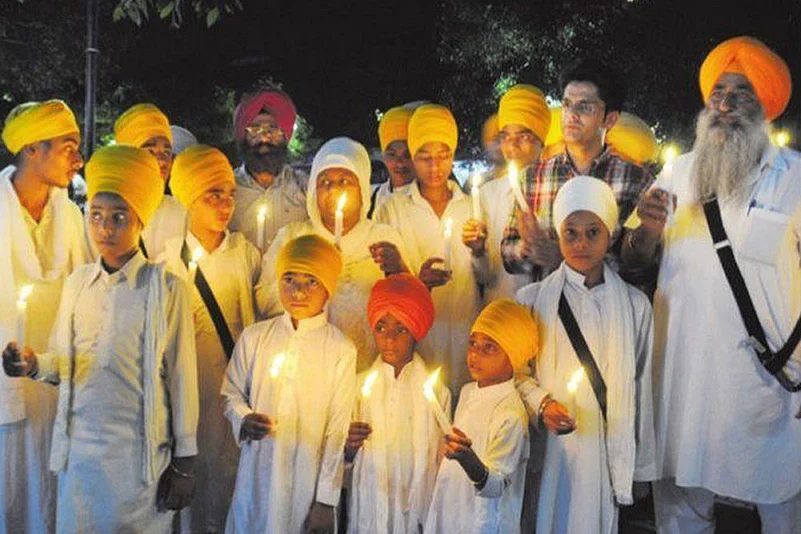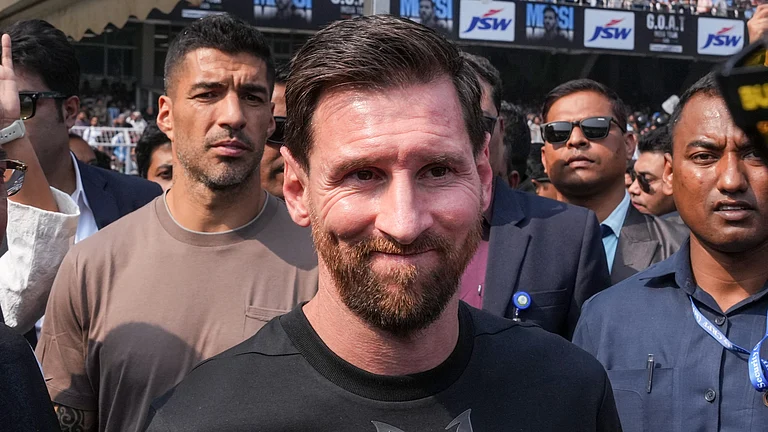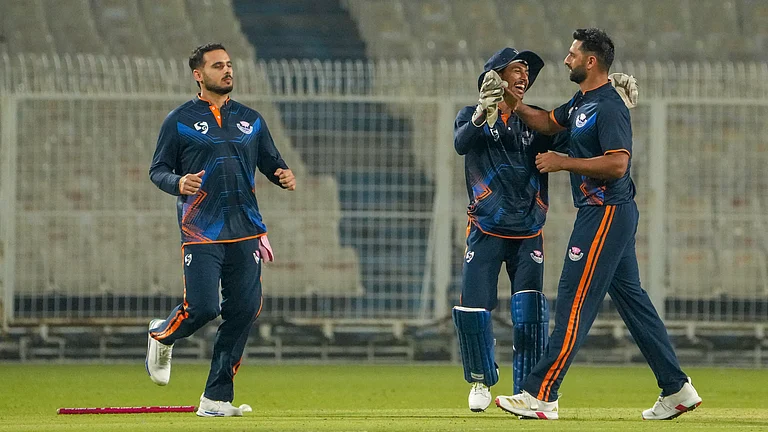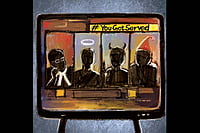In November 1, 1984, some time after 2 pm, The Indian Express reporter Sanjay Suri headed to Gurudwara Rakabganj after hearing of trouble there. He found Kamal Nath leading a mob of about 4,000 while a police contingent headed by additional commissioner Gautam Kaul, first cousin to Indira Gandhi, stood by. Earlier in the day, the mob had burned two Sikh men to death. Their bodies lay there burning as the mob made desultory attempts to enter the gurudwara.
In his book 1984: The Anti-Sikh Violence and After, Suri points out that the mob was completely under Kamal Nath’s control and composed seemingly of Congressmen. Clearly, Kamal Nath stayed there for several hours without attempting to disperse the crowd. He also made no attempt to ensure the bodies of those burnt to death were carried away by the police, or handed over to their kin in the gurudwara. In the context of the massacres of 1984 and 2002, this was the one clear incident where a credible witness could point to a senior politician’s presence at the head of a mob of party workers at the scene of the violence.
Given this background, it is difficult to imagine why the Congress appointed him the Punjab in-charge for the coming assembly elections in the first place, a decision they were forced to rescind. According to former CM Amarinder Singh, he was “appointed party in-charge (of the state) by the party president...” This answer takes us to the heart of the matter. Sonia Gandhi took the decision overlooking Kamal Nath’s past, choosing to illustrate how the Congress is unlikely to ever be apologetic about the 1984 violence.
The violence against the Sikhs ended in the first week of November 1984 and even then it was clear to the public that, at the least, a number of mid-level Congress partymen had instigated and led the murderous mobs. Yet, in the run-up to the general elections at the end of December, the Congress ran a divisive and communally charged campaign with the Sikhs cast as villains. It was masterminded by Rajiv Gandhi’s cousin and Man Friday Arun Nehru.
Barely a month after his electoral victory, Rajiv gave his first interview to India Today, where he said a judicial inquiry would not “help at the moment. It would raise issues which are really dead.” It was only two months later, in April, that such a probe was announced. Subsequent events proved that Rajiv was not interested in reviving issues that “were already dead”, rather the probe was only a bargaining tool to bring the Sikh leadership to the negotiating table.
The Supreme Court judge appointed to carry out the probe, Ranganath Misra, had strange ideas of fairness. While the names of victims were divulged and they were cross-examined in open court, officials deposed privately behind closed doors with no cross-questioning. The media was barred, illegally, from reporting the proceedings.
This media failure explains why Congress leaders such as Amarinder Singh can claim today that Kamal Nath’s name never came up before the probe. In fact, newspapers had picked up his name during the course of the violence and Suri filed an affidavit before the commission naming Kamal Nath. In his letter to Sonia Gandhi asking to be relieved from the post, Kamal Nath writes, “Till 2005, not a single public statement, complaint or FIR was ever made against me, and the first time my name was ever mentioned in any forum was 21 years after 1984.”

Kids from families of those massacred in the 1984 anti-Sikh pogrom
This is an outright lie. On November 3, 1984, The Statesman reported, “Policemen criticised the role of politicians too. Several councillors, they alleged, interceded on behalf of violent mobs when policemen tried to stop arson. Officers wondered what Mr Kamal Nath was doing at Rakabganj.” Suri’s affidavit, filed a few months later, was detailed and forms the basis for the facts I have set out in the initial paragraphs.
If Misra chose not to examine Kamal Nath, despite the affidavit, it says nothing about Kamal Nath’s innocence, but does say a lot about why Misra was eventually given a Rajya Sabha seat by the Congress. When the Nanavati Commission finally examined the case against Kamal Nath 20 years later, it concluded:
“Reply filed by Shri Kamal Nath is vague. He has not clearly stated at what time he went there and how long he remained there. The situation at the Gurudwara had become very grave at about 11.30 am and continued to remain grave till about 3.30 pm. The evidence discloses that Shri Kamal Nath was seen in the mob at about 2 pm. The Police Commissioner had reached that place at about 3.30 pm. So he was there for quite a long time.
He has not stated whether he went to the Gurudwara alone or with some other persons and how he went there. He has not stated that he looked for the police or tried to contact the policemen who were posted there for ensuring that the situation remained under control.
He left that place after the Commissioner of Police arrived. He has not stated that he met him. He was a senior political leader and feeling concerned about the law and order situation went to the Gurudwara and, therefore, it appears a little strange that he left that place abruptly without even contacting the police officers who had come there.
At the same time, it is also required to be considered that he was called upon to give an explanation after about 20 years and probably for that reason he was not able to give more details as regards when and how he went there and what he did.”
Clearly, it was not Kamal Nath’s innocence, but the dubious and discretionary favour done by Misra that saved him from indictment. It must indeed have taken some gall to claim in his letter to Sonia that “the Nanavati commission set up by the NDA government after proper investigation fully absolved me”.
This history of his role in the 1984 massacres didn’t stop Kamal Nath’s rapid rise within the party hierarchy and he continued to enjoy the confidence of the Nehru-Gandhi family. His aborted appointment as Punjab in-charge was a reaffirmation of the party’s attitude on 1984. That attitude also explains why, despite the claim about Sonia Gandhi doing so, no representative has ever apologised on behalf of the Congress for its role in the violence.
But why exactly has the party persisted with this attitude and failed to take measures that would so clearly be in its political self-interest? Letting go of Kamal Nath, Jagdish Tytler and Sajjan Kumar would lose the party nothing electorally. An unqualified apology by either Sonia or Rahul would help the party move on, and put enormous pressure on Narendra Modi and the BJP over the 2002 violence in Gujarat.
Only one possible answer makes sense. In a recent piece for The Caravan on 1984, I quoted Avtar Singh Gill, petroleum secretary of that time. He told me that the day after Indira Gandhi’s assassination (November 1), Rajiv’s associate, hotelier Lalit Suri, had come to his office and told him to stay home for three days.
“Clearance has been given by Arun Nehru for the killings in Delhi and the killings have started,” he told Gill. “The strategy is to catch Sikh youth, fling a tyre over their heads, douse them with kerosene and set them on fire.” Arun Nehru, at that time, enjoyed Rajiv’s complete confidence and acted on his behalf, hinting the party’s institutional involvement in the violence went all the way up to the top. Only this explains the Nehru-Gandhi family and the party’s prevarications over 1984 and why a man like Kamal Nath was ever named its Punjab in-charge.
(Hartosh Singh Bal is political editor, The Caravan)
Slide Show
According to Who Are the Guilty?, report of a fact-finding by civil rights groups PUDR and PUCL on the 1984 po grom, the attacks on Sikhs in Delhi and its suburbs, “far from being a spontaneous expression of ‘madness’ and of popular ‘grief and anger’ at Indira Gandhi’s assassination, were the result of a well-organised plan marked by acts of deliberate commissions and omissions” by important politicians of Congress(I) and administrative officials.
























